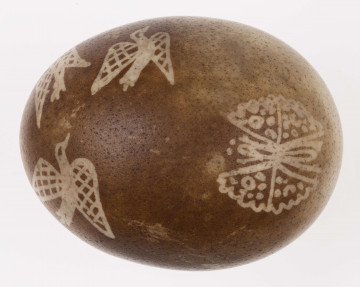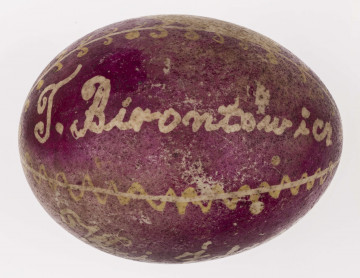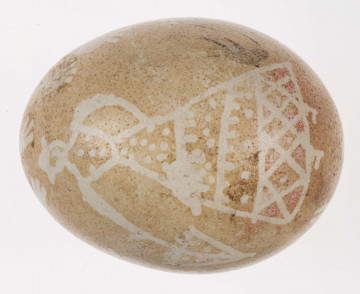
Easter egg
1901 — 1920
National Museum in Lublin
Part of the collection: Folk Art of the Lublin Region (17th–1st half of the 20th c.)
An Easter egg is an attribute of Easter. The egg was a symbol of life, fertility, love and strength, and the symbolism of ornaments written on it played an important magical role. In the Lublin region, eggs were most often decorated using the batik technique, which involved writing a design with melted wax using a marker made of sheet metal in the form of a funnel set on a stick (see also E/1038/ML, E/1082/ML, E/1117/ML).
According to the type of ornaments, Easter eggs from Lublin can be divided into two main groups: northern, where one-coloured pattern with straight lines prevails, and southern, with multi-coloured and numerous volute ornaments; in the central part of Lublin region influences of the groups intermingled and multi-coloured ornaments with straight lines occurred. Additionally, in the ornamentally rich southern group the following subgroups were distinguished depending on the area where the colours and motifs were used: Biłgorajska, Zamojska, Hrubieszowska and Tomaszowska. The Hrubieszów type was characterised by ornaments in white, yellow and red colours on a black, brown and onion background, sometimes violet. Among the patterns influences from neighbouring Volhynia prevailed, especially the motif called beech rose. This was not an image of a natural rose in the form of more or less geometrised petals, leaves or stems, but mainly multiplied and interpenetrating triangles and rhomboids, referring in their shape to the star, a symbol of destiny. Stars were believed to belong to the order of the afterlife and at the same time to be luminous openings in the sky. Observing them was helpful in measuring the rhythm of the changes of day and night, and numerous prophecies about the farm were also based on star gazing.
In the ethnographic collection of the National Museum in Lublin, there are around 2500 Easter eggs made by artists from the Lublin region. Most of them were made in the years 1950-1980, while a significant number (around 500), unfortunately of unknown authorship, date from the early 20th century. This Easter egg is one of the oldest.
Author / creator
Dimensions
cały obiekt: height: 4,7 cm
Object type
Easter egg
Technique
batik
Material
wax, egg, plant-based pigment,
Creation time / dating
Creation / finding place
Owner
The National Museum in Lublin
Identification number
Location / status

1901 — 1920
National Museum in Lublin

1901 — 1920
National Museum in Lublin

1901 — 1920
National Museum in Lublin
DISCOVER this TOPIC
Museum of King Jan III's Palace at Wilanów
DISCOVER this PATH
Educational path